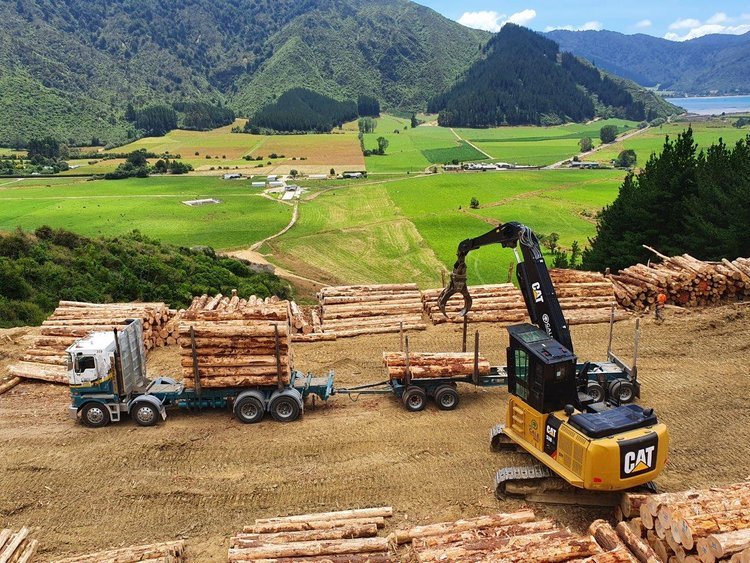FM Group Newsletter
Autumn 2022
Introduction
FROM THE DIRECTORS
Welcome to the Autumn edition of our newsletter.
Well another year is bringing a new range of challenges and opportunities for everyone. Covid restrictions are easing, and we are seeing overseas travel to some destinations, and here, opening up again. At the same time, we have the war in Ukraine, which is hard to imagine in this day and age. Climate change is front of news most days (with parts of New Zealand sinking and some rising!!). How agricultural emissions will be accounted for is a lively debate and coming to a head in the next few months – trees will play a role in that. House building is booming in New Zealand, as long as you can get materials and trades, and interest rates seem on the way up along with the cost of everything due to all of the factors above.
Forestry is not immune to any of this, we are seeing international shipping rates rise steeply, demand in China fall as they enforce Covid lockdowns, high domestic log demand, increases in new planting and ETS registrations rise as carbon prices increase.
We believe there will potentially be some large changes in the international wood markets as supply from Russia and Ukraine is stopped and markets will need to find new sources of supply especially as Covid subsides in China.
Its going to be an interesting ride but we remain positive about the future for forestry and all other industries in New Zealand.
Dave Janett
Director
Cancer Society Tranz Alpine Scooter Safari
It's not long until our eight scooter riders take off on their mission to ride from Christchurch to the West Coast! Keep your eyes peeled for some lumberjacks flying up Porters Pass (or walking up it. time will tell)
All of the riders have been busy raising funds for the Cancer Society and if you want to make a donation please click on the links below:
https://scootersafari.org.nz/evan-macclure
https://scootersafari.org.nz/debbie-lee
https://scootersafari.org.nz/adrian-loo
https://scootersafari.org.nz/dave-chandler
https://scootersafari.org.nz/louise-wilson
https://scootersafari.org.nz/corban-lilley
https://scootersafari.org.nz/iain-macdonald
https://scootersafari.org.nz/glenn-moir
Here are the stallions we will be taking on the 250km endurance ride over the Southern Alps:
Adrian’s Hell Rider
Corban’s Black Beauty
Evan’s Chinese Chariot
DC’s Hotted Up Super Scooter
Iain’s Racy Number
Glenn’s Hurricane
Debbie’s Little Pink Frances
Louise’s Cute Wee Cassie
Drones in Forestry
Unmanned aerial vehicles (UAV), or more commonly referred to as drones, have come a long way over the last couple of decades and have become essential tools used across many industries. Forestry has well and truly taken advantage of this advancement in technology as drones have quickly become a key go-to tool in many aspects of forestry operations.
Current use
One of the most common uses of drones in forestry is aerial surveying of blocks. Stands can quickly and easily be surveyed by air; using the drone to take photos, drop pins at areas of interest, and mark tracks and boundaries. A job that would take hours on foot now takes a matter of minutes.
In some circumstances a high resolution, up to-date aerial map is required for accurate planning. This is easily achievable with drones. The drone is set on an automated flight path taking a series of photos which are stitched together to create a single, continuous map. These maps are critical for salvage operations and forests with natural stocking gaps.
Forests that experience large scale windthrow events will need to be salvaged to recover lost timber. It is not always in the forest owner’s best interest to harvest all trees and may want to leave the still standing stock (this is becoming more common with the addition of carbon). These salvage plans need recent imagery to decide what should be harvested/salvaged and what should be left standing. From drone imagery, hard harvest boundaries can be developed.
Forests that have significant stocking gaps need high resolution maps to remove these unstocked areas and, therefore, get an accurate forest area allowing us to make more accurate volume estimations.
Where to from here?
Drones are more capable than simply taking photos and dropping markers. We are seeing drones automate more and more processes, such as quality control and assessing residuals left on the cutover.
Aerial imagery paired with the right software can assess if correct stocking targets are being met. Built in artificial intelligence can identify individual trees and calculate the stocking. This is currently being used in thinning quality control.
LiDAR, Light detecting and ranging, creates 3D models by sending out beams of light and measuring the time it takes for the light to return after bouncing off objects. This 3D imagery has endless possibilities within the forestry sector.
With LiDAR we can map the terrain to an accuracy of a few centimetres allowing us to create highly accurate slope and terrain maps; essential for harvesting crews working on steep slopes.
We can also create 3D maps containing individual trees. From this we can estimate the volume of timber to a higher level of accuracy than ever before. This isn’t limited to standing trees either; it can be used for logs on a skid or piles of gravel/roading material.
With LiDAR drone packages costing upwards of $40,000, this technology is yet to become widespread within the forestry sector.
Drones have become an integral part of forestry, replacing traditional forestry operations, increasing efficiency and accuracy, and saving time. This is definitely a space to watch to see cool, new innovations into the future.
Woodside Forest
John and Rosalie Wardle have been FML clients since 2002. Their Woodside Forest property is located within the Southern Alps foothills approx. 20km south of Oxford township.
Woodside Forest is an example of a small forest holding of 121 ha which includes both indigenous and exotic forests. One area consists of 84 ha of regrowth and old crop indigenous forest, primarily Black Beech, in addition to 27 ha of primarily Radiata Pine. Remainder is house site and paddocks.
Since 2002 FML has been involved with John and Rosalie with production thinning and marketing their pruned stands of Radiata Pine.
Their management plan has been to harvest the largest of the trees, 600mm plus of DBH, leaving the smaller trees to put on diameter. Once the areas have been tinned out, regen pine has grown and then this has been pruned and thinned also.
In addition to Radiata production they have harvested various yearly volume of Black Beech on a sustainable permit. While FML have assisted with the harvesting, John and Rosalie have had these logs milled and air dried on their property, and also carried out their own marketing.
They have cut and sold firewood from the material not suitable for milling, and have carried out silvicuture operation of pruning and thinning on the regen Black Beech.
Woodside Forest regime is probably not for everybody. It has only been successful due to both John and Rosalie’s hard work and great enthusiasm.
While this article is only a very short snapshot of how this forest operates, the writer doesn’t do it justice. However for those who wish to have more information, John has written a book titled “Woodside: A small forest managed on multiple use principles”.
From the Backpage
WELCOME AND GOOD BYE!
We would like to thank Damian and Matt for the great job they have done for our company and we wish them all the best for their future roles, either in farming for Matt, or new forestry areas for Damian.
Richard Pearson took over the role of Harvest Manager in North Canterbury region.
Richard has been “born under a pine tree” in Otago. He has been involved in forestry and everything related to it for his whole life. He has had various roles; including planting, pruning, spraying, thinning, clear felling, breaking out and machines. He enjoys all the challenges forestry can throw at him and will bring a new fresh eye to our harvest operations team.
In his spare time he enjoys taking his family away in the caravan, fishing or just exploring. He also does competitive wood chopping.
Previous issues
Summer 2021 – 22 Newsletter
In this issue: Cancer Society Tranz Alpine Scooter Safari, ETS Cutover & Carbon Stock Update, Log Export Market Update, New Faces at TFM in Marlborough
Spring 2021 Newsletter
In this issue: ETS – Carbon Price Update, The Age-Old Question, Windthrow and ETS
























